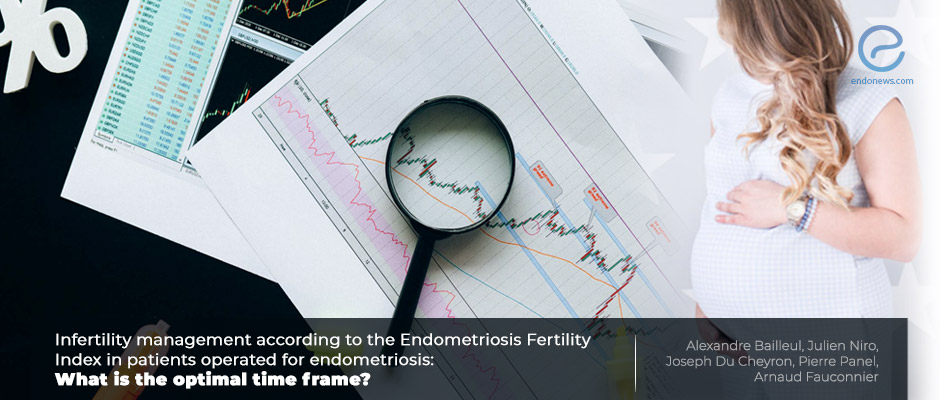Postoperative infertility management using Endometriosis Fertility Index in endometriotic women
Jun 7, 2021
Endometriosis Fertility Index helps postoperative ART decision
Key Points
Importance:
- "Endometriosis Fertility Index" is a scoring system to predict the endometriotic women's postoperative spontaneous pregnancy rate.
Highlights:
- Endometriosis patients with a favorable "Endometriosis Fertility Index" should wait for spontaneous pregnancy after infertility surgery, but those with unfavorable scores, should be referred for ART.
What's done here:
- This bi-center prospective cohort study was conducted in the research centers of Poissy-Saint-Germain and Versailles in France between January 2012 and June 2018.
- Specifically competing risk analysis was used to evaluate fertility, namely spontaneous vs ART conception, to evaluate the relation between fertility and "Endometriosis Fertility Index".
Key Results:
- Spontaneous pregnancy occurred in 104/234 women after their surgery in a 24 months interval, 58 (55.8%) being spontaneous conceptions.
- "Endometriosis Fertility Index" was favorable (≥5) in the spontaneous conception group.
- On the contrary, "Endometriosis Fertility Index" was unfavorable (≤4) for pregnancies necessitating Artificial Technology.
- Fecundability decreased from 12 months for EFI (0-4) and from 24 months for EFI (5-10).
Limitations:
- The patient number is small in the groups for the analysis for "time to conception".
- The information about the precise duration of pregnancy attempt is not clarified, as postoperative hormonal treatment or pain could postpone natural conception.
- It is not clear how and when planned ART programs for postoperative women in case of failing spontaneous pregnancies.
Lay Summary
"Endometriosis Fertility Index '' score, described by the World Endometriosis Society in 2017, is a robust score and assists to predict the spontaneous pregnancy rate of women with endometriosis, within 3 years after their operation. Its calculation is possible by patient characteristics such as age, pregnancy history, the duration of infertility, endometriosis stage, and the functional postoperative score assessed by the surgeon. The patients with an unfavorable "Endometriosis Fertility Index '' necessitate more assisted reproductive techniques compared to the patients with a favorable "Endometriosis Fertility Index ''. This is based on the recent paper by Bailleul et al. from France, published in the May 2021 issue of "PLoS One".
The authors planned this bi-centered prospective cohort study to reveal the operability of EFI scoring while adjusting spontaneous pregnancy expectancy after the infertility operation of endometriotic patients. As patients have two competing events, namely spontaneous conception and ART conception, they used a specific competing risk analysis approach to explore the relation between "Endometriosis Fertility Index" and fertility. Competing risk analysis allows to correctly estimate marginal probability of an event in the presence of competing events.
The authors analyzed 234 patients from two research centers from France, and all patients included in the study voluntarily were diagnosed with endometriosis-related infertility and underwent laparoscopic fertility-sparing resection of endometriotic implants and adhesions. Patients who had negative pathological results of endometriosis and who had multiple pelvic surgical interventions for endometriotic adhesions were excluded. Follow-up by questionnaire after 12 months of surgery included the questions about the occurrence time and the way of the pregnancy as spontaneous or with the help of ART.
During the follow-up period, 104 (44%) got pregnant, 58 of which were spontaneously conceived, and the rest had obtained postoperative ART. High "Endometriosis Fertility Index" scores (≥5) were associated with the spontaneous pregnancy group while scores were low (≤4) in the group necessitating assisted reproductive technology.
"Our analysis suggests that patients with an unfavorable "Endometriosis Fertility Index" have more ART pregnancies and should be referred for assisted reproduction shortly after surgery", the authors concluded.
Research Source: https://pubmed.ncbi.nlm.nih.gov/33979371/
infertility laparoscopy postoperative spontaneous pregnancy ART EFI endometriosis.

